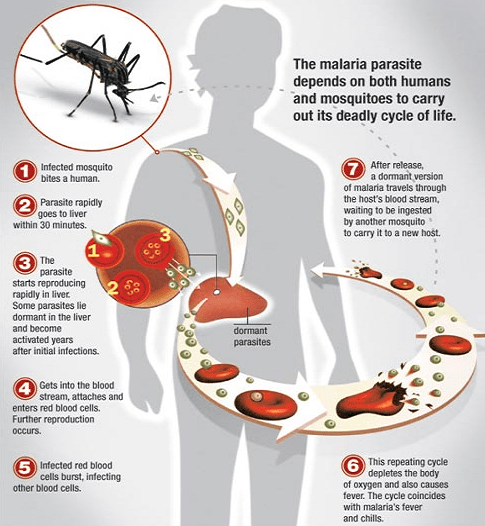Researchers Use Laser Optical Tweezers To Show How Malaria Parasite Infects RBCs
Malaria, an infectious disease spread by mosquitoes, affects hundreds of millions of people and is also responsible for a million deaths every year across the globe. It is caused when a parasite, Plasmodium falciparum, invades one red blood cell (RBC) after another and blocks the capillaries that take blood to the brain and other organs. The process of invasion and infection of the RBCs is so swift that researchers hardly get to study the infection stages. To facilitate the development of more effective drugs and vaccines for the disease, Cambridge University researchers are now using a tool called laser optical tweezers for analyzing the critical process of interaction between the parasite and red blood cells.

Credit: malariahotspots.co.uk
The most crucial stage for the survival of a parasite is the erythrocyte invasion by plasmodium merozoite which leads to pathogenesis - development of malaria. The researchers has been intensively studying the invasion process but the disease-causing parasite after infecting one RBC invades another in less than a minute and after 2-3 minutes of release, the parasite losses it’s potential to infect the cells. The researchers used laser optical tweezers because it can control the movements of cells. The precise and accurate control is done by applying very small forces with extremely focused beam of laser. The optical tweezers was used to select parasites that had just emerged from a RBC and delivered them to another blood cell. This method is useful for scrutinizing the invasion process.

Optical Tweezers delivering merozoite to a healthy erythrocyte
The researchers also tried to find out how strongly the parasites stick to the blood cells. They found that the adherence between the parasite and the RBCs is weak and can be blocked by using antibodies or drugs. Moreover, they showed how three different invasion-inhibiting drugs affect the interactions between the erythrocyte and merozoite by using this technique.

Forcible Detachment of merozoite from erythrocyte surface via Optical Tweezers
The study titled #-Link-Snipped-# was published in Biophysical Journal.
Source: #-Link-Snipped-#
Credit: malariahotspots.co.uk
The most crucial stage for the survival of a parasite is the erythrocyte invasion by plasmodium merozoite which leads to pathogenesis - development of malaria. The researchers has been intensively studying the invasion process but the disease-causing parasite after infecting one RBC invades another in less than a minute and after 2-3 minutes of release, the parasite losses it’s potential to infect the cells. The researchers used laser optical tweezers because it can control the movements of cells. The precise and accurate control is done by applying very small forces with extremely focused beam of laser. The optical tweezers was used to select parasites that had just emerged from a RBC and delivered them to another blood cell. This method is useful for scrutinizing the invasion process.
Optical Tweezers delivering merozoite to a healthy erythrocyte
The researchers also tried to find out how strongly the parasites stick to the blood cells. They found that the adherence between the parasite and the RBCs is weak and can be blocked by using antibodies or drugs. Moreover, they showed how three different invasion-inhibiting drugs affect the interactions between the erythrocyte and merozoite by using this technique.
Forcible Detachment of merozoite from erythrocyte surface via Optical Tweezers
The study titled #-Link-Snipped-# was published in Biophysical Journal.
Source: #-Link-Snipped-#
Replies
You are reading an archived discussion.
Related Posts
Wearing glasses or contact lenses for being able to read or see properly has become more common than ever before, thanks to the constant viewing of display screens. What if...
The Reserve Bank Of India (RBI) is likely to begin an experiment in select few cities in India to test the possibility of replacing the regular paper-based currency notes with...
Researchers and experts always try to think out of the box. They have once again leveraged such extraordinary thinking by making use of background sounds such as the noise of...
Just read the news that the government of Karnataka has made it illegal to like or share objectionable content uploaded on social media sites like Facebook, twitter, YouTube, Google Plus...
When it comes to an ultra low cost phones, the market in India is hugely dominated by the Google's Android OS smartphones. Giving a stiff competition to that, here comes...
